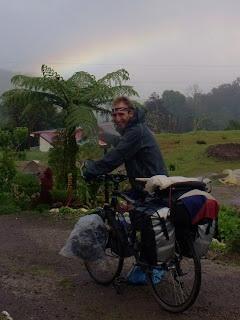Mat had caught a glimpse of a quetzal at Cloudbridge, with its long tail trailing behind it as it flew. The Resplendent Quetzal is one of the most sought-after birds in Costa Rica, with a brilliant green back and wings, ruby-red breast, and a tail on the males that can be as long as 25 inches -- almost twice as long as his body. To even the score (Elizabeth had never seen a quetzal), we decided to spend a night in the mountains at the aptly-named
Mirador de Quetzales. Stay here, the guidebooks proclaim, and you are "virtually guaranteed" to see a quetzal on the early-morning guided hike that comes included with the price of your lodging.
What's more, Mirador de Quetzales is on the way from Uvita to San Jose, which would be a slog of about 7 hours if we did it all in one day. But there aren't a lot of buses out of Uvita -- we didn't leave until 2:00, which got us to the 4:30 bus leaving San Isidro for San Jose. We wanted to get off at kilometer 70, we explained to the bus driver. At Los Quetzales? He asked. This seemed like a good sign.
As the bus climbed up into the mountains, it started raining and getting dark. We'd been watching the km markers on the side of the road, but soon couldn't see them anymore. After a while I got up and made my way to the front of the bus to ask,
quanto falta a los Quetzales - how much further?
The bus driver slapped his forehead and started apologizing. We had just passed it a kilometer ago, and he had forgotten to stop. Did we want to get off here and walk back? This was a dubious prospect on the shoulderless Interamericana highway, in the cold, rain, and dark, I thought. A nice lady in the front seat said the same thing out loud, and in much better Spanish. Soon, she and the bus driver hatched a plot, which I half-understood: somehow we were going to meet up with a bus headed from San Jose to San Isidro, transfer over, and be dropped off. We didn't really understand how the driver expected to flag down the other bus. But it wouldn't be a disaster to just go all the way to San Jose a day early, so we just settled back into our seats to see what would happen.
Soon all became clear -- the buses make a pit stop at a restaurant around the halfway point on the San Isidro-San Jose route. And sure enough, when our bus pulled in, the bus going in the opposite direction was also stopped. Our driver explained to the other what was going on, and we moved our stuff. And we made a call to the hotel from the restaurant, asking them to come pick us up at the highway and give us a lift the rest of the way to the hotel (about a km). We also put on several more layers of clothing -- it was cold up there at 8500 ft!
When the bus stopped, we got off in the dark, huddling in the cold rain long enough to find a headlamp, not even positive we were in the right place until we were able to light up the hotel's small sign. There was no one there to meet us. We started hiking up the road and they came soon enough, taking us up to the lodge, where we sat in front of a little fire in a woodstove and ate a couple of big bowls of soup.
Also hanging out by the fire were a couple of guys trying to tune a guitar. When we finished dinner Matt let on that he knew how to tune it, and made instant friends. We learned that the owner of the guitar was a teenager who was part of the family running the hotel, while the other guy was a heart-broken Czech who had sold most of his belongings and proceeded to bike from New York, to San Francisco, to Costa Rica, and was continuing south. (At some point we put it together that he had camped in Greenbelt Park and along the C&O Canal during his journeys, two spots we visit fairly regularly around DC). We played some bluegrass and some Czech songs before discovering Matt and the guitar owner had a shared repertoire of Metallica and Black Sabbath songs. You haven't heard Atomic Funeral until you've heard it sung by a 15-year old Tico playing a nylon-string acoustic.
That night, we snuggled tight under many blankets. Lonely Planet says the rooms have heat. Ours consisted of a hot water bottle provided by the hotel.
In the morning, we woke to more cold and rain.
But the tours go on, rain or shine, so our guide met us at 6:15 to go quetzal hunting. After about 20 minutes he was clearly starting to get frustrated -- they really must find quetzals pretty easily in these woods. But after a while longer, sure enough, he spotted a female quetzal, and a little while later, the male who was taking an interest in her. We spent a while watching them, moving around just enough to keep watching as they flew from tree to tree.
Finally, the birds flew and we couldn't find them anymore. So we headed back for a hot breakfast, and said our goodbyes to Peter the crazy Czech cyclist. It was still raining, off and on, but a rainbow in the near distance seemed like a good omen for his journey.
There was time for one more hike, to one more waterfall, before we got back on the bus to San Jose for our flight out the next morning. Even in the cold and rain Costa Rica is beautiful.











